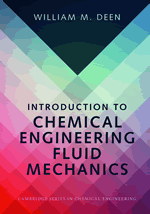Deen, W. M., Introduction to Chemical Engineering Fluid Mechanics.
Cambridge University Press, Cambridge, UK, 2016.
 Designed for single-semester undergraduate courses in fluid mechanics for chemical engineers, this textbook illustrates the fundamental concepts and analytical strategies in a rigorous and systematic, yet mathematically accessible manner. It guides readers through the use of dimensional analysis and order-of-magnitude estimation for identifying which forces are important in different settings, and explains friction factors for pipes and other conduits, terminal velocities of particles, drops, and bubbles, and flow in porous media, packed beds, and fluidized beds. It also describes the physical and mathematical distinctions among major flow regimes, including unidirectional flow, the lubrication approximation, creeping flow, pseudosteady flow, irrotational flow, laminar boundary layers, turbulent shear flow, and compressible flow. Including numerous worked examples and end-of-chapter problems to illustrate key concepts, and with a full solutions manual for instructors available at www.cambridge.org/deen, it is the ideal text for students looking to master the fundamentals of the subject. |
Deen, W. M., Analysis of Transport Phenomena, 2nd ed.
Oxford University Press, New York, 2012

This textbook, published originally in 1998, was revised extensively in 2012. Intended for use in graduate-level courses for chemical engineers, it provides a unified treatment of momentum, heat and mass transfer, emphasizing concepts and analytical techniques that apply to all of these transport processes. The first few chapters establish the tools for later analyses, while also covering heat and mass transfer in stationary media. The similarities among the "molecular" or "diffusive" transport mechanisms--heat conduction, diffusion of chemical species, and viscous transfer of momentum--are highlighted. Conservation equations for scalar quantities are derived first in general form, and then used to obtain the governing equations for total mass, energy, and chemical species. Scaling and order-of-magnitude concepts that are crucial in modeling are also introduced. Certain key methods for solving the differential equations in transport problems, including similarity, perturbation, and eigenfunction expansion techniques, are described using conduction and diffusion problems as examples. Following are several chapters devoted to fluid mechanics, beginning with fundamental equations for momentum transfer and then discussing unidirectional flow, nearly unidirectional (lubrication) flow, and laminar boundary layer flow. Forced-convection heat and mass transfer in laminar flow, free convection, and turbulence are then covered. A chapter on multicomponent energy and mass transfer introduces the variety of effects that occur when species and energy fluxes are coupled. A new chapter is devoted to transport in electrolyte solutions, including both macroscopic (electroneutral) systems and microscopic ones in which a net charge concentration gives rise to electrokinetic phenomena. The first appendix summarizes vector and tensor operations and relations involving various coordinate systems. A second appendix, which is new, provides a concise review of solution methods for ordinary differential equations and of the properties of special functions that arise frequently in transport problems. An Instructor's Resource CD, available to adopters of the text, includes all figures and solutions to all end-of-chapter problems. It may be obtained by contacting Oxford University Press in New York. A list of errata is updated periodically on this site. See: Errata Transport. |